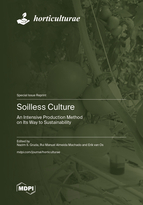Soilless Culture—An Intensive Production Method on Its Way to Sustainability
A special issue of Horticulturae (ISSN 2311-7524). This special issue belongs to the section "Protected Culture".
Deadline for manuscript submissions: closed (30 September 2023) | Viewed by 22513
Special Issue Editors
Interests: vegetables; climate change; horticulture; soilless culture; growing media; protected cultivation; greenhouse production
Special Issues, Collections and Topics in MDPI journals
Interests: vegetable crops; vegetable production systems; greenhouse and open-field systems; fertigation; root dynamics; salinity; organic fertilization and soilless cultivation
Special Issues, Collections and Topics in MDPI journals
Interests: horticulture; plant production systems; water quality; cropping systems; water purification; hydroponics; soilless culture
Special Issue Information
Dear Colleagues,
The prognosis suggests that the area of soilless culture will be dramatically increased in the future, both in protected and open field horticulture. This will be associated with the increased use of growing media in nurseries, herbaceous plants, such as vegetables, ornamentals, medicinal and aromatic plants, and some small fruits and woody crops. Soilless cultures are called intensive-sustainable systems. However, are they sustainable or on their way to being sustainable?
Today, solutions are needed to reduce or replace peat, increase nutrient and water use efficiency, and introduce circular waste flows. Using locally available and renewable raw materials, appropriate substrate mixtures, biostimulants, and adapted high techniques, such as Artificial Intelligence and the Internet of Things, could help us to construct a new strategy for cultivating soilless plants. This Special Issue aims to focus on recent progress in solutions to increase the sustainability of production in intensive horticulture without compromising yield and quality. Another objective will be to examine recent advances in the characterization and utilization of novel growing materials for plant production systems. On the other hand, reducing production costs is needed in these systems. Therefore, we welcome high-quality research publications and reviews covering all related topics in soilless culture and growing media and closely related research areas.
Prof. Dr. Nazim Gruda
Prof. Dr. Rui Manuel Almeida Machado
Dr. Erik van Os
Guest Editors
Manuscript Submission Information
Manuscripts should be submitted online at www.mdpi.com by registering and logging in to this website. Once you are registered, click here to go to the submission form. Manuscripts can be submitted until the deadline. All submissions that pass pre-check are peer-reviewed. Accepted papers will be published continuously in the journal (as soon as accepted) and will be listed together on the special issue website. Research articles, review articles as well as short communications are invited. For planned papers, a title and short abstract (about 100 words) can be sent to the Editorial Office for announcement on this website.
Submitted manuscripts should not have been published previously, nor be under consideration for publication elsewhere (except conference proceedings papers). All manuscripts are thoroughly refereed through a single-blind peer-review process. A guide for authors and other relevant information for submission of manuscripts is available on the Instructions for Authors page. Horticulturae is an international peer-reviewed open access monthly journal published by MDPI.
Please visit the Instructions for Authors page before submitting a manuscript. The Article Processing Charge (APC) for publication in this open access journal is 2200 CHF (Swiss Francs). Submitted papers should be well formatted and use good English. Authors may use MDPI's English editing service prior to publication or during author revisions.
Keywords
- abiotic and biotic stress management
- artificial intelligence and the Internet of Things
- biofortification
- biostimulants for soilless culture systems
- carbon footprints, lifecycle analysis, climate change, and intensive sustainable systems
- compost utilization in growing media
- circular growing media, alternative to peat and mineral wool
- developments in remote growing
- fertilization: threshold limits of sodium, etc.
- green roof technology, vertical farming, and how to restrict costs and increase profitability
- growing media analysis, formulation, and characterization and engineering
- growing systems for new soilless crops, such as cannabis, freesia, and berries
- novel inorganic and organic materials, such as waste and digestates, sphagnum moss, biochars, and hydrochars
- organic soilless production
- organic waste management and circular horticulture
- organic fertilizers
- pathogen elimination and cleaning pipework
- plant propagation
- recirculation of nutrient solution
- root-medium properties, architecture, and plant nutrition
- soilless culture and understanding of crop physiology and quality aspects
- stability and biodegradation of growing media
- water quality
- water-/nutrient-use efficiency, automation








